How to Fertilize Avocado Tree: A Step-by-Step Guide for Lush Growth
- February 16, 2024
- 16 comment
Master avocado tree care with our guide on precise fertilization techniques for peak growth and fruit production. Avocado trees, with their lush foliage and bountiful fruit, are a rewarding addition to any home garden or orchard. Proper fertilization is key to ensuring the health and productivity of these trees. This guide provides a comprehensive overview of how to fertilize your avocado tree, ensuring it receives the nutrients it needs for optimal growth and fruit production.
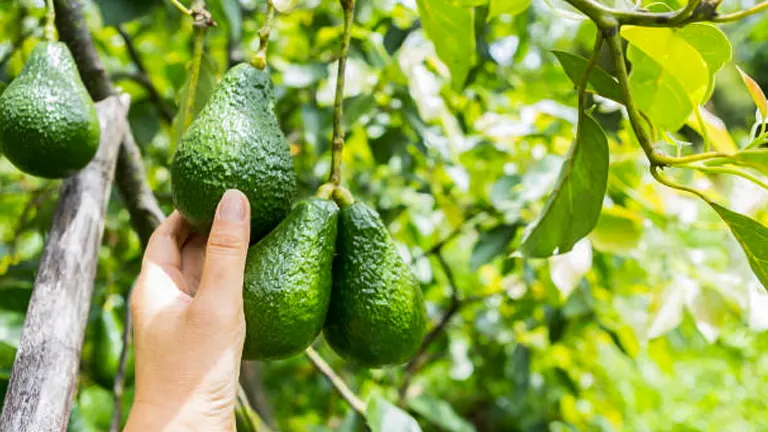
Proper fertilization is key to ensuring the health and productivity of these trees. This guide provides a comprehensive overview of how to fertilize your avocado tree, ensuring it receives the nutrients it needs for optimal growth and fruit production.
List of Guides on How to Fertilize Avocado Trees
Assessing Your Tree’s Needs
Choosing the Right Fertilizer
Timing and Frequency of Application
Proper Application Techniques
Monitoring and Adjusting
Understanding Avocado Tree Nutrition
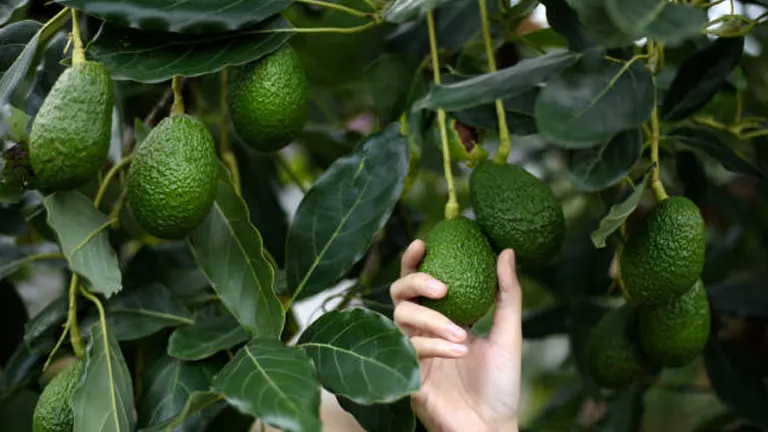
A robust avocado tree is the product of a finely balanced diet, composed of macro and micronutrients, each serving a pivotal role in the tree’s development.
Essential Nutrients and Their Functions
- Nitrogen (N): Acts as the cornerstone of growth, promoting vigorous leaf and stem development.
- Phosphorus (P): Essential for the formation of roots and flowers, phosphorus underpins the reproductive success of the tree.
- Potassium (K): Enhances fruit quality, bolsters disease resistance, and aids in water regulation within the plant.
- Calcium (Ca), Magnesium (Mg), and Sulfur (S): These secondary nutrients fortify the plant’s overall health, contributing to cellular integrity and metabolic processes.
- Micronutrients (Iron, Zinc, Manganese, Boron): Though required in smaller quantities, these elements are critical for enzyme function and the synthesis of chlorophyll.
Comprehensive Nutritional Guide for Avocado Trees
A well-balanced nutritional plan is critical for the health and productivity of avocado trees. This guide combines essential macroelements, secondary nutrients, and micronutrients into a single table, detailing their roles, signs of deficiency, and corrective measures.
| Nutrient (Element) | Function | Deficiency Symptoms | Remedial Actions |
|---|---|---|---|
| Nitrogen (N) | Promotes vegetative growth | Chlorosis, reduced growth | Apply nitrogen-rich fertilizer |
| Phosphorus (P) | Supports root and flower development | Dark, reddish-purple leaves, poor fruiting | Increase phosphorus levels in soil |
| Potassium (K) | Critical for water regulation, disease resistance | Leaf necrosis, weak fruit set | Supplement with potassium |
| Calcium (Ca) | Essential for cell integrity, growth | Blossom end rot, deformed leaves | Add lime or gypsum to soil |
| Magnesium (Mg) | Key for photosynthesis | Interveinal chlorosis, leaf curling | Apply Epsom salts (magnesium sulfate) |
| Sulfur (S) | Involved in protein synthesis | Uniform yellowing, stunted growth | Use sulfur-containing fertilizers |
| Iron (Fe) | Vital for chlorophyll synthesis | Interveinal chlorosis, pale leaves | Apply iron chelates foliar spray |
| Zinc (Zn) | Important for enzyme function | Reduced leaf size, rosetting | Use zinc sulfate application |
| Manganese (Mn) | Necessary for chlorophyll production | Interveinal chlorosis, speckled leaves | Apply manganese sulfate |
| Boron (B) | Crucial for cell wall formation, fruit development | Brittle growth, fruit drop, hollow stem | Supplement with boron |
Key Insights and Practices for Nutritional Management
- Precision in Nutrient Management: Tailoring nutrient applications based on specific deficiencies not only supports the health of the avocado tree but also contributes to environmental sustainability by avoiding overuse of fertilizers.
- Regular Soil and Leaf Testing: Conducting periodic testing helps in accurately identifying nutrient needs and adjusting fertilization practices accordingly.
- Integrated Approach: Combining organic and inorganic sources of nutrients can optimize tree health and productivity. Organic matter improves soil structure and nutrient availability, while targeted inorganic supplements can quickly correct specific deficiencies.
- Environmental Considerations: Understanding the impact of local soil conditions, weather patterns, and water availability on nutrient uptake is crucial for effective nutrient management.
This comprehensive guide aims to empower avocado growers with the knowledge to identify and correct nutritional deficiencies, ensuring their trees receive a balanced diet for optimal growth and fruit production. Regular monitoring, accurate diagnosis, and precise nutrient management are key to cultivating healthy and productive avocado trees.
Diagnosing Nutritional Deficiencies
The symptoms of nutrient deficiencies can be subtle, yet their impact on tree health and productivity is significant. Recognizing these signs early is key to corrective action:
- Nitrogen deficiency manifests as general chlorosis (yellowing) of the leaves, particularly in older foliage, accompanied by reduced growth rates.
- Phosphorus deficiency can cause leaves to darken and take on a reddish-purple tint, with diminished flowering and fruiting.
- Potassium deficiency is evident through leaf edge necrosis (tip burn), weak fruit set, and overall reduced vigor.
Selecting the Right Fertilizer for Healthy Avocado Trees
- N-P-K Fertilizers with a Ratio of 10-10-10 or 20-20-20: These balanced fertilizers are excellent for young trees, providing equal parts of nitrogen, phosphorus, and potassium. They promote overall health and are especially useful for establishing young trees.
- Nitrogen-Rich Fertilizers (e.g., Urea, Ammonium Sulfate): For mature avocado trees, a higher nitrogen content is beneficial to support leaf and branch growth. Products like urea or ammonium sulfate are good choices, but should be used judiciously to prevent excessive foliage growth at the expense of fruit production.
- Organic Composts and Manures: Composted organic matter, chicken manure, or well-rotted cow manure are excellent sources of slow-release nutrients. They improve soil structure, enhance microbial life, and provide a broad spectrum of essential nutrients.
- Fish Emulsion and Seaweed Extracts: These are excellent sources of micronutrients and are particularly useful for their quick-acting effect. They can be applied as foliar sprays or directly to the soil, providing a boost in micronutrients like zinc, boron, and manganese, which are vital for the tree’s health.
- Specialty Avocado or Citrus Fertilizers: Many brands offer fertilizers formulated specifically for avocado and citrus trees. These products are designed to meet the unique nutritional demands of these trees, often including a balanced N-P-K ratio along with essential micronutrients. Examples include the Espoma Citrus-tone or Dr. Earth Organic Fruit Tree Fertilizer, which are tailored for fruit-bearing trees, ensuring they receive the right mix of nutrients.
- Micronutrient Supplements: For targeted deficiencies, products like zinc sulfate, manganese sulfate, and borax can address specific needs. These should be used based on soil test results that indicate a deficiency.
Comprehensive Guide to Fertilizing Avocado Trees
Step 1: Assessing Your Tree’s Needs

Understanding Nutritional Requirements: Before applying any fertilizer, it’s essential to assess the specific needs of your avocado tree. Young trees, for example, require nutrients to support rapid growth, particularly nitrogen for leaf and stem development. Mature trees, on the other hand, benefit from a balanced approach that supports both the tree’s structure and fruit production. Observing your tree’s growth patterns, leaf color, and overall health can provide initial clues to its nutritional needs.
Conducting a Soil Test: A professional soil test is the most accurate way to determine these needs. This test will reveal not only the pH level of your soil but also specific nutrient deficiencies. Avocado trees prefer a slightly acidic to neutral pH (around 6.0 to 7.0). If the pH is not within this range, nutrient uptake can be affected, regardless of the fertilizer used.
Step 2: Choosing the Right Fertilizer
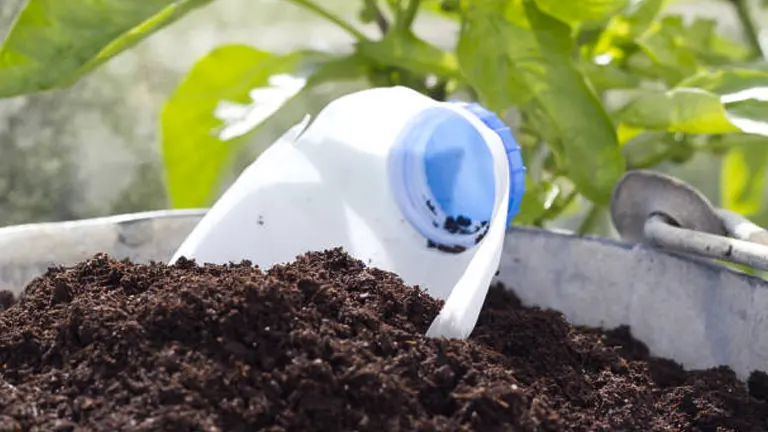
Selecting a Formula: With the knowledge gained from your soil test, choose a fertilizer that addresses your tree’s specific needs. For general growth, a balanced fertilizer (such as a 10-10-10 NPK ratio) is often recommended. However, if your soil test indicates a deficiency in a particular nutrient, you might opt for a formula with a higher concentration of that nutrient.
Organic vs. Synthetic: Consider whether you prefer organic fertilizers, which release nutrients slowly and improve soil health over time, or synthetic fertilizers, which are more immediately available to your tree but can contribute to salt buildup in the soil. Organic options like compost, fish emulsion, and bone meal are excellent for improving soil structure and fertility.
Step 3: Timing and Frequency of Application
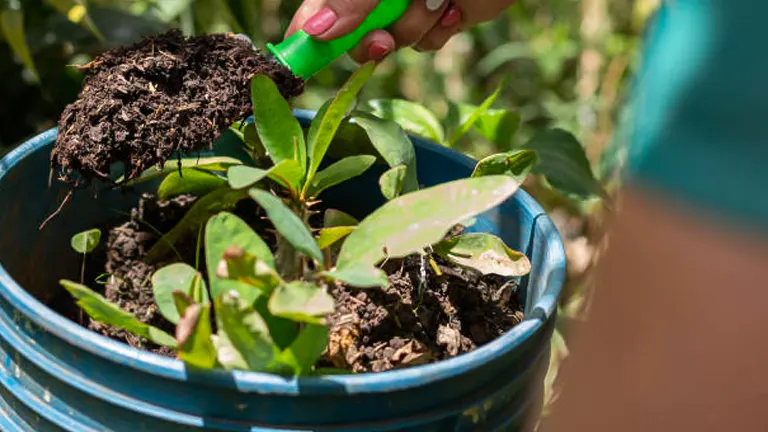
Seasonal Considerations: Fertilizing at the right time of year is crucial for the health of your avocado tree. Generally, the beginning of the growing season in early spring is the best time to start fertilizing, as the tree awakens from dormancy and can make the most of the added nutrients. Additional applications can be made throughout the growing season, with the final application in late summer or early fall to avoid promoting new growth that won’t survive winter frosts.
Age of the Tree: Young trees benefit from more frequent, lighter applications of fertilizer to avoid overloading their developing root systems. In contrast, mature trees can handle larger, less frequent applications as their extensive root systems can absorb and store nutrients more effectively.
Step 4: Proper Application Techniques
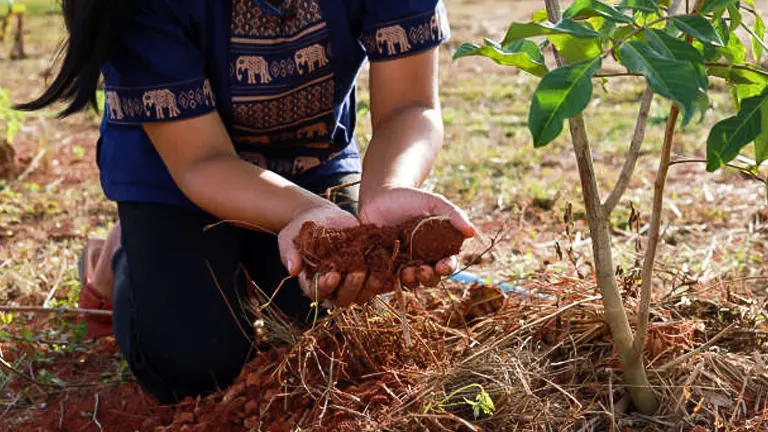
Distributing Fertilizer Evenly: Apply fertilizer evenly around the drip line of the tree, which is the outer perimeter of the tree’s canopy where rainwater naturally drips off the leaves. This method encourages roots to grow outward and strengthens the tree’s stability and nutrient uptake efficiency. Avoid applying fertilizer too close to the trunk, as this can lead to root burn and other damage.
Watering After Application: Thorough watering after applying fertilizer helps to dissolve the nutrients and carry them into the soil where the tree’s roots can absorb them. This step is particularly important in dry conditions to ensure that the fertilizer does not remain on the soil surface, where it can be wasted or cause harm.
Step 5: Monitoring and Adjusting
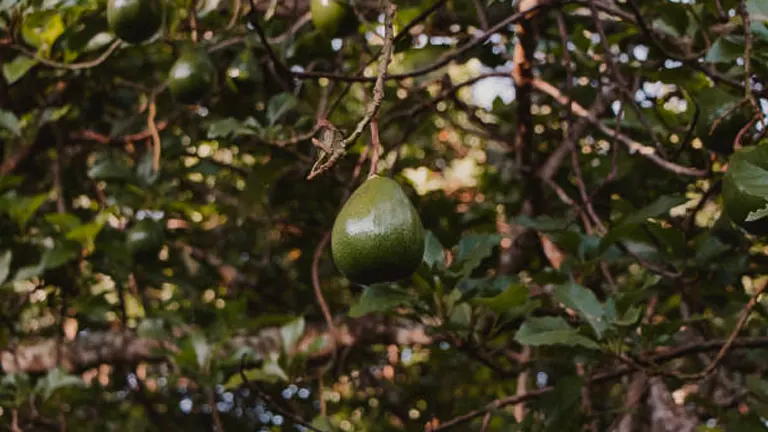
Observing Tree Response: After fertilizing, monitor your tree’s response over the following weeks and months. Signs of improvement, such as more vigorous growth, greener leaves, and increased fruit production, indicate that your fertilization plan is effective. Conversely, signs of distress, such as leaf burn or yellowing, may suggest over-fertilization or the need for pH adjustment.
Adjusting Your Approach: Fertilization is not a “set it and forget it” task. Continuous observation, soil testing every few years, and adjusting your fertilization strategy based on your tree’s growth and health are essential for ongoing success. What works one year may need to be tweaked the next, as your tree’s needs and soil conditions change.
Micronutrient Sprays
In addition to soil fertilization, foliar sprays can address micronutrient deficiencies directly. Spraying the leaves with a solution containing zinc, manganese, or boron can be particularly effective if soil conditions limit nutrient uptake.
Scientific Analysis and Recommendations
| Micronutrient | Recommended Concentration in Foliar Spray | Deficiency Symptoms | Notes |
|---|---|---|---|
| Zinc (Zn) | 0.5 – 1.0% Zn solution | Leaf discoloration, stunted growth | Apply 2-4 times annually during active growth. |
| Manganese (Mn) | 0.5 – 1.0% Mn solution | Interveinal chlorosis, yellowing leaves | Best applied in the early morning or late afternoon for optimal absorption. |
| Boron (B) | 0.2 – 0.5% B solution | Fruit drop, poor fruit set, hollow stem in seedlings | Use caution to avoid over-application, which can be toxic. |
Considerations and Advanced Tips:
- Timing and Frequency: Application timing is crucial; early morning or late afternoon sprays reduce the risk of leaf burn and ensure better absorption due to lower evaporation rates. Additionally, applying these sprays during periods of active growth maximizes benefit.
- Combining Micronutrients: While it’s possible to mix micronutrients in a single spray, it’s essential to avoid combinations that can precipitate out of solution or become less bioavailable. For instance, mixing calcium with phosphorus or sulfur can reduce effectiveness.
- Monitoring and Adjusting: Continuous observation of the tree’s response is vital. Leaf tissue analysis can provide the most accurate measure of the tree’s micronutrient status and guide future applications.
Implementing foliar sprays as part of your avocado tree care routine can swiftly address micronutrient deficiencies, promoting healthier trees and potentially increasing fruit yield. The scientific approach to concentration and application ensures that the trees receive the right amount of nutrients at the optimal time, making this method a precise tool in the hands of an informed gardener.
Seasonal Fertilization Schedule for Avocado Trees
Creating a fertilization schedule that aligns with the growth cycle of your avocado tree is key to its health and productivity. Here’s a general guideline to follow through the seasons:
Spring (Early Growth Season)
- Initial Application: Apply a balanced fertilizer as new growth appears. If soil tests indicate deficiencies, adjust the fertilizer composition accordingly.
- Micronutrient Check: If your tree showed signs of micronutrient deficiencies last season, consider a foliar spray now.
Summer (Peak Growth and Fruit Development)
- Follow-up Applications: Continue with nitrogen-rich fertilizations every 4-6 weeks. These applications support fruit development and tree growth.
- Hydration Focus: Ensure the tree is adequately watered, especially after fertilizing, to facilitate nutrient uptake.
Fall (Preparation for Dormancy)
- Final Application: Make the last fertilizer application by late summer or early fall to avoid stimulating new growth that won’t withstand winter temperatures.
Winter (Dormant Season)
- Rest Period: Avoid fertilizing during this time. Focus on maintaining soil moisture at a reduced level, as the tree’s water and nutrient needs decrease.
Common Fertilization Mistakes and How to Avoid Them
Over-Fertilizing
- Risk: Can lead to nutrient burn, leaf drop, and even death of the tree.
- Prevention: Always follow recommended amounts based on soil tests and tree size.
Fertilizing at the Wrong Time
- Risk: Stimulating growth that cannot harden off before cold weather.
- Prevention: Stick to the seasonal schedule and avoid late-season applications.
Improper Application
- Risk: Nutrient runoff or concentration in one area, leading to uneven growth.
- Prevention: Spread fertilizer evenly around the drip line and not against the trunk.
Ignoring Soil pH
- Risk: Nutrients may become unavailable to the tree, regardless of fertilization.
- Prevention: Test soil pH regularly and adjust as needed to maintain a range of 6.0 to 6.5.
Monitoring and Adjusting Fertilization Practices
Observing Tree Response
Regular observation of your avocado tree’s health is crucial. Signs of over-fertilization, such as leaf burn or yellowing, and under-fertilization, evidenced by stunted growth or poor fruiting, should prompt an adjustment in your fertilization strategy. Seasonal variations and tree maturity also play roles in nutrient needs, making flexibility in your approach essential.
Soil Re-testing
Annual or bi-annual soil tests can guide your fertilization practices more accurately over time. Changes in soil composition, pH levels, and nutrient availability can occur, necessitating adjustments to maintain optimal growing conditions.
Expert Consultation
When in doubt, consulting with a local extension service, arborist, or experienced avocado grower can provide tailored advice and solutions to specific challenges you might face.
Beyond Fertilization: Advanced Avocado Tree Care Techniques

While proper fertilization is pivotal for the health and productivity of avocado trees, comprehensive care extends into pest management, disease prevention, and optimizing environmental conditions. This section delves into these aspects, ensuring your avocado tree thrives in all dimensions.
Pest Management
Avocado trees can fall prey to various pests, such as the avocado lace bug, thrips, and mites. Integrated pest management (IPM) strategies, including regular monitoring, biological controls, and environmentally friendly pesticides, can effectively manage pest populations while minimizing harm to beneficial organisms.
Biological Controls
Introducing natural predators, such as ladybugs to combat mites, can provide long-term pest control without the need for chemical interventions.
Disease Prevention
Root rot, caused by Phytophthora cinnamomi, is a common and serious disease affecting avocado trees. Ensuring well-drained soil, applying mulch to regulate soil moisture, and using fungicides judiciously can help prevent this and other diseases.
Cultural Practices
Proper pruning to enhance air circulation and sunlight penetration within the canopy reduces the risk of fungal diseases. Additionally, sanitizing pruning tools between uses helps prevent the spread of pathogens.
Optimizing Environmental Conditions
Avocado trees flourish in environments that mimic their native habitat. Adequate sunlight, protection from extreme weather, and soil enriched with organic matter create ideal growing conditions.
Watering Practices
Deep, infrequent watering encourages the development of a strong root system. Adjust watering schedules based on season, weather conditions, and the tree’s life stage to avoid over or under-watering.
Conclusion
Fertilizing avocado trees correctly is key to nurturing their lush growth and maximizing fruit production. This guide has provided essential steps and insights, from assessing nutritional needs to applying fertilizers strategically. The core message is clear: with the right knowledge and approach, anyone can support their avocado tree in reaching its full potential, ensuring both health and abundance.
FAQs
- What’s the best time of year to fertilize my avocado tree?
Ideally, fertilize your avocado tree in early spring as new growth begins and then periodically through the growing season, stopping before the onset of winter to prevent new growth that could be damaged by cold. - How often should I fertilize my young avocado tree?
Young avocado trees benefit from lighter, more frequent fertilization, approximately every 2-3 months during the growing season, to support their rapid growth without overwhelming them. - Can over-fertilizing harm my avocado tree?
Yes, over-fertilizing can lead to nutrient burn, characterized by yellowing or browning leaf edges, and can severely affect the tree’s health. It’s crucial to follow recommended dosages based on soil tests. - What kind of fertilizer does my avocado tree need?
Avocado trees require a balanced fertilizer with nitrogen, phosphorus, potassium (N-P-K), and essential micronutrients like zinc, manganese, and boron. The exact formulation can vary based on soil test results. - Is organic fertilizer better for avocado trees?
Organic fertilizers are beneficial for improving soil health and structure, offering a slow-release of nutrients. They can be particularly effective for avocado trees when complemented with targeted micronutrient supplements as needed. - How do I apply fertilizer to my avocado tree?
Fertilizer should be applied around the drip line of the tree, which is the outer perimeter of its canopy, to encourage root growth outward. Avoid placing fertilizer too close to the trunk to prevent root burn. - What are signs of nutrient deficiency in avocado trees?
Symptoms include yellowing leaves (nitrogen deficiency), reddish-purple leaves (phosphorus deficiency), leaf edge burn (potassium deficiency), and weak fruit set or poor growth overall, each indicating a lack of specific nutrients. - Can I use a foliar spray to fertilize my avocado tree?
Foliar sprays are effective for quickly addressing micronutrient deficiencies, as they allow the tree to absorb nutrients directly through its leaves. They are best used as a supplementary treatment alongside soil fertilization.
With the right fertilization approach, your avocado tree can flourish, promising lush growth and abundant fruits. This guide aims to simplify that process, leading you towards a thriving garden. Happy growing!

Benjamin Brooks
Forestry AuthorGreetings! I'm Benjamin Brooks, and my journey over the past 15 years has revolved around the fascinating realms of content creation, expertise in snow clearing, and the intricate world of lumberjacking and landscaping. What began as a simple curiosity about the natural world and heavy machinery has evolved into a passionate profession where my love for crafting words intertwines seamlessly with my lumberjacking and garden skills.
16 comments
Thank you for an excellent article, really enjoyed it. It reinforced most of the good practices I’m aware of. Thank you.
Joseph Kaman
February 22, 2024 7:59 pmI have enjoyed the article it is a very good report as I m a grower of the same I have got three trees I have learned a lot thanks keep it up
Peter chifunda
February 21, 2024 7:05 amGood guide to avocado farming
William mbiga
February 20, 2024 7:53 pmThank You!
Benjamin Brooks
February 20, 2024 10:37 pmThese past few months I have planted 11 Avocado trees that I grew from seeds. They are doing very well but your well informed information on fertilizer techniques is so appreciated.
Valerie Hathaway
February 20, 2024 1:27 pmWow! Glad to hear that.
Benjamin Brooks
February 20, 2024 10:39 pmGood advice to a famer
AGNES
February 20, 2024 8:35 amI have.. RIO🥑farm-LTD 500 trees at Chogoria Tharaka Nithi County
Evans M Kiruja
February 19, 2024 4:17 pmI have planted 5 x avocado trees in my home garden. They are eight years old. However, they produce lot of flowers but surprisingly after fruit setting all small fruits fall down and only three fruits remain in each tree. Kindly assist me in coming up with the correct solution hence I like them and plan to grow much more.
Motala Geofrey Sefako
February 19, 2024 9:40 amIf your avocado trees are dropping fruit, focus on even watering and a nutrient check-up based on a soil test. Consider adding diverse avocado varieties for better pollination, and keep those trees well-pruned for health. Watch out for pests and extreme weather, and remember, some trees just take their time to bear fruit.
Benjamin Brooks
February 22, 2024 11:18 amI learned a good thing here
Richard Mwaikenda
February 19, 2024 5:53 amIndeed it is very comprehensive article. Would you please guide about plant to plant and row to row distance for avocado orchard,especially medium or high density farming and also training pruning techniques. Thanks
Iqtidar Baig
February 18, 2024 12:58 pmIt's a very good article & wish I could be learning a lot of things from you. Also make your your articles easy to send to other readers.
Felix Mwasuka
February 18, 2024 9:01 amLike your article..very useful for me as med scale farmer of hass avo







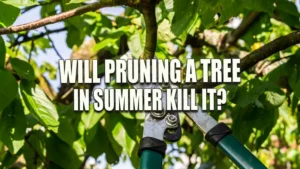


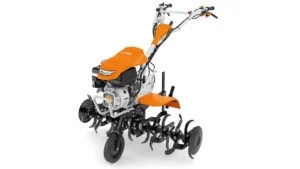


Thank you very much for the information. How do I register to your newsletter.
Sunil Manisunker
February 24, 2024 4:39 amI'm glad you found the information helpful! To sign up for our newsletter, please visit our website Forestry.com
Benjamin Brooks
February 26, 2024 7:02 am